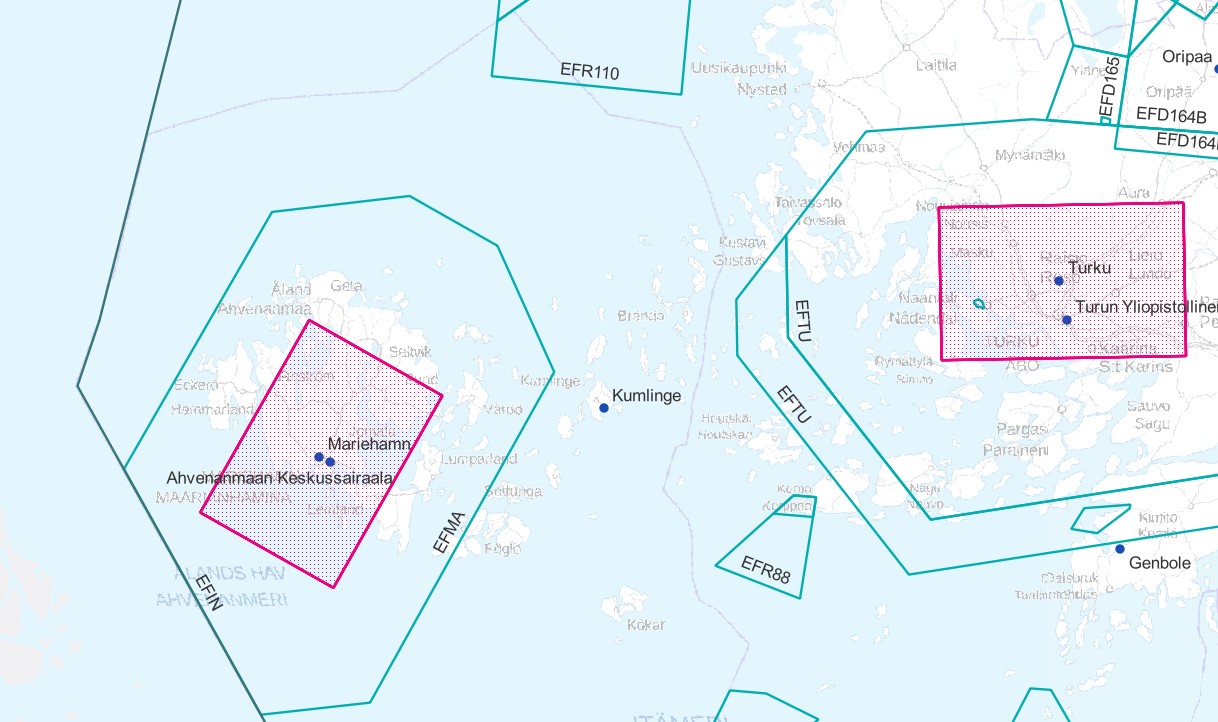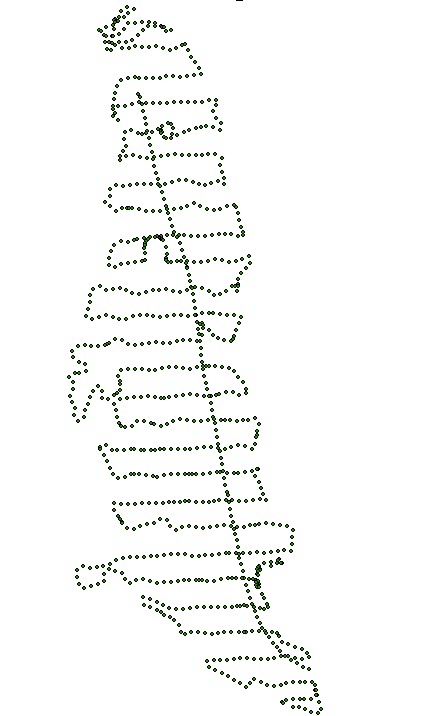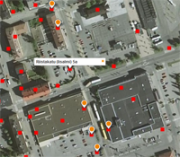2017
Type of resources
Available actions
Topics
Keywords
Contact for the resource
Provided by
Years
Formats
Representation types
Update frequencies
Service types
Scale
Resolution
-

Air traffic network-product is a link-knot routing dataset compliant with INSPIRE requirements. It includes f.ex. flight routes and aerodromes. Data shall not be used for operational flight activities or flight planning. INSPIRE Air Traffic Network-product includes spatial information of air traffic network in accordance with the INSPIRE Directive. The data has been retrieved from the EAD database maintained by Eurocontrol. Information is updated regularly but is not constantly up to date. Data can be used for purposes that are in accordance with the INSPIRE Directive, but shall not be used for operational flight activities or flight planning. ANS Finland www.ais.fi –site provides information for operational flight activities or flight planning Available layers Aerodrome Node: Node located at the aerodrome reference point of an airport/heliport, which is used to represent it in a simplified way.DEFINITION Aerodrome Reference Point (ARP): The designated geographical location of an aerodrome, located near the initial or planned geometric centre of the aerodrome and normally remaining where originally established [AIXM3.3].DEFINITION Airport/heliport: A defined area on land or water (including any buildings, installations and equipment) intended to be used either wholly or in part for the arrival, departure and surface movement of aircraft/helicopters [AIXM5.0]. Air Route Link: A portion of a route to be flown usually without an intermediate stop, as defined by two consecutive significant points Air Space Area: A defined volume in the air, described as horizontal projection with vertical limits. Designated Point: A geographical location not marked by the site of a radio navigation aid, used in defining an ATS route, the flight path of an aircraft or for other navigation or ATS purposes. Instrument Approach Procedure: A series of predetermined manoeuvres by reference to flight instruments with specified protection from obstacles from the initial approach fix, or where applicable, from the beginning of a defined arrival route to a point from which a landing can be completed and thereafter, if a landing is not completed, to a position at which holding or en route obstacle clearance criteria apply. Navaid: One or more Navaid Equipments providing navigation services.DEFINITION Navaid equipment: A physical navaid equipment like VOR, DME, localizer, TACAN or etc. Procedure Link: A series of predetermined manoeuvres with specified protection from obstacles. Runway Area: A defined rectangular area on a land aerodrome/heliport prepared for the landing and take-off of aircraft. Runway Centerline Point: An operationally significant position on the center line of a runway direction. Standard Instrument Arrival: A designated instrument flight rule (IFR) arrival route linking a significant point, normally on an ATS route, with a point from which a published instrument approach procedure can be commenced. Standard Instrument Departure: A designated instrument flight rule (IFR) departure route linking the aerodrome or a specific runway of the aerodrome with a specified significant point, normally on a designated ATS route, at which the en-route phase of a flight commences. Surface Composition: Runway surface material CTR (Not INSPIRE): A control zone (CTR) is a block of Controlled Airspace extending from the surface of the earth to a specified upper limit.
-
This dataset represents the density of all IMO registered ships operating in the Baltic Sea. Density is defined as the number of ships crossing a 1 x 1km grid cell. It is based on HELCOM AIS (Automatic Identification System) data. The HELCOM AIS network hosts all the AIS signals received by the Baltic Sea States since 2005. The AIS Explorer allows to compare density maps of different ship types per month: http://maps.helcom.fi/website/AISexplorer/ The data was processed to produce density maps and traffic statistics. All scripts are available in GitHub: https://github.com/helcomsecretariat. The production of these maps have been carried out 2016-2017 through the HELCOM project on the assessment of maritime activities in the Baltic Sea. The underlying AIS data processing work has been co-financed by EU projects Baltic Scope (2015-2017 EASME/EMFF/2014/1.2.1.5) and Baltic Lines (2016-2019, Interreg Baltic Sea Region). In addition, the Ministry of the Environment of Finland supported the work with a special contribution in view of the use of the results in the HOLAS II process.
-
The Arctic SDI Gazetteer Service is a service that contains authoritative place names data from the arctic area. The service can be used for searching place names and performing reverse geocoding. The service contains about 2.87 million place name locations with about 3.15 million place names. It contains data from following sources: * Canada (Natural Resources Canada, updated: 02/2018) * Denmark (including Greenland) (SDFE, updated: 05/2017) * Finland (National Land Survey of Finland, updated: 04/2017) * GEBCO Undersea feature names gazetteer (updated: 04/2019) * Iceland (National Land Survey of Iceland, updated: 08/2017) * Norway (Norwegian Mapping Authority, updated: 08/2017) * Russia (Russian Mapping Agency, updated: 04/2019) * Sweden (Swedish National Mapping Agency, updated: 05/2017) * USA (US Geological Survey, updated: 05/2017)
-
Biomassa-atlaksen yritystoiminnan jätetiedot kuvaavat ympäristölupa- ja raportointivelvollisten yritysten vuosittain tuottamien biohajoavien jätteiden määriä. Aineisto perustuu ympäristöhallinnon valvonta- ja kuormitustietojärjestelmään (VAHTI) kirjattuihin jätetietoihin, joita on jatkokäsitelty Suomen ympäristökeskuksessa. Biohajoavia jätteitä syntyy kuitenkin myös muilta kuin VAHTIin raportoivilta yrityksiltä. Koska kaikki biohajoavia jätteitä tuottavat yritykset tai toiminnot eivät ole ympäristölupavelvollisia tai raportointivelvollisia VAHTIin nähden, on kyseistä jätevirtaa Biomassa-atlaksessa tarkasteltu tiettyjä, erityisesti biohajoavia jätteitä käsitteleviä laitoksia koskevien tietojen avulla. VAHTIn kompostointi-, biokaasu- ja jätepolttoaineen valmistuslaitoksilta lähtevät biohajoavat jätemäärät on otettu Biomassa-atlaksen jätteenkäsittelylaitosten aineistoon mukaan. Kyseiset laitokset ovat ympäristölupavelvollisia, ja ne vastaanottavat biohajoavaa jätettä myös niiltä toimijoilta, joiden jätemääriä ei ole mukana Biomassa-atlaksen yritysten jätemäärätiedoissa. On kuitenkin huomioitava, että tiedot saattavat olla osittain päällekkäisiä yritysten biohajoavien jätemäärien kanssa, ja tästä syystä niitä ei pidä tarkastella kartalla yhtä aikaa. Jätteenkäsittelyn biohajoava jätemäärätieto antaa kuitenkin lisäinformaatiota, kun tavoitteena on biohajoavien jätevirtojen ohjaaminen entistä enemmän hyödyntämiseen. Biomassa-atlaksen jätteenkäsittelylaitosten biohajoava jätemäärätieto (t/v) on ilmoitettu jäteasetuksen (Vna jätteistä 179/2012, liite 4) mukaisten jäteluokkien mukaan. Lisäksi lietteille on käytössä kirjaintarkenne A-G, joka ilmaisee lietteen käsittelytavan. Biomassa-atlaksessa jätetiedot on edelleen luokiteltu viiteen pääluokkaan edellä mainittujen EWC-jäteluokkakoodien perusteella: 1) eläin- ja kasvijäte, 2) liete, 3) paperi- ja pahvijäte, 4) puujäte ja 5) sekajäte. Pääluokkien lisäksi jätemäärätiedot jakautuvat vielä tarkemmin 62 alaluokkaan. Jäteluokitus on esitetty Biomassa-atlaksen verkkosivulla. Tiedot päivitetään Biomassa-atlakseen kerran vuodessa. Viimeisin päivitys koskee vuotta 2015. Jätemäärätiedoista ei käy ilmi yksittäisen jätteentuottajan nimi.
-
Harjavallan kaupungin Karttapalvelu on WMS-rajapintapalvelu, jonka kautta on katseltavissa seuraavat karttatasot: Vesihuollon toiminta-alueet, Yleiskaavayhdistelmä, Asemakaavayhdistelmä, Pohjakartta, Virastokartta, Osoitekartta. Palvelu perustuu Harjavallan kaupungin hallinnoimiin aineistoihin. Palvelun käyttö on maksutonta ja ei vaadi autentikointia eli tunnistautumista käyttäjätunnuksen ja salasanan avulla.
-
Aineisto sisältää suunnittelutarvealueen, joka on Tuusulassa asemakaavoitetun alueen ulkopuolinen alue. Suunnittelutarvealue on maankäyttö- ja rakennuslain mukanaan tuoma käsite, jonka avulla määritellään yksityiskohtaista maankäytön suunnittelua vaativat alueet. Suunnittelutarvealueiden käyttöön liittyvien tarpeiden täyttömiseksi on syytä ryhtyä erityisiin toimenpiteisiin, kuten esimerkiksi teiden, vesijohdon tai viemärin rakentamiseen. Maankäyttö- ja rakennuslain 16 § 1 momentissa on määrätty suunnittelutarvealueista, jota koskevia säännöksiä sovelletaan myös 16 §:n 2 momentissa mainittuun rakentamiseen. MRL:n 72 §:ssä säädetään suunnittelutarpeesta ranta-alueella. Aineistoa päivitetään tarvittaessa. Aineisto on luotu leikkaamalla Tuusulan kuntarajan muodostamasta alueesta pois asemakaavoitettujen alueiden ulkorajojen mukaiset alueet.
-
Helsingin kaupungin karttapalvelu on internetissä toimiva kansalaisten käyttöön suunnattu karttojen katselupalvelu, jonka kautta pystyy myös tutustumaan joihinkin aineistojen ominaisuustietoihin sekä myös lataamaan joitakin aineistoja tiedostomuodossa.
-

Aineisto kattaa ympäristöhallinnon tekemien sisävesien (järvet, joet) luotauksien syvyystiedot. Tietoja käytetään järvien ja jokien syvyysaineiston (syvyyskäyrät ja -alueet sekä maksimisyvyyspiste) tuottamiseen. Luotauspisteisiin on yhdistetty luotauksen lähtötasotieto sekä järvien osalta järvien fysiografiatietoja SYKEn ylläpitämästä järvirekisteristä. Aineisto kuuluu SYKEn avoimiin aineistoihin (CC BY 4.0) Lisätietoja: https://geoportal.ymparisto.fi/meta/julkinen/dokumentit/Luotaus.pdf
-

Iisalmen kaupungin osoiterekisteri/ vahvistetut osoitteet ylläpidetään Oracle tietokannassa ja julkaistaan Ylä-Savon karttapalvelussa. Osoitteelle määritetään sijainti ETRS-Gk27 koordinaatistossa. Aineistosta saa erilaisia raportteja ja listauksia.
-
Vantaan kaupungin paikannuspalvelu on rest-rajapintapalvelu, jonka kautta on saatavilla osoite- ja kiinteistörekisteristä tuotetut paikannustiedot pistemäisinä ETRS-GK25FIN (EPSG:3879) koordinaatteina esitettynä. Data palautetaan JSON-muodossa. Palvelua voi käyttää sekä geokoodaukseen eli sijainnin hakemiseen osoitteelle tai kiinteistölle, että käänteiseen geokoodaukseen, eli lähimmän osoitteen tai kiinteistön hakemiseen sijainnin perusteella. Aineistoja hallinnoi Vantaan kaupunki. Palvelun käyttö on maksutonta eikä vaadi autentikointia eli tunnistautumista käyttäjätunnuksen ja salasanan avulla.
 Paikkatietohakemisto
Paikkatietohakemisto